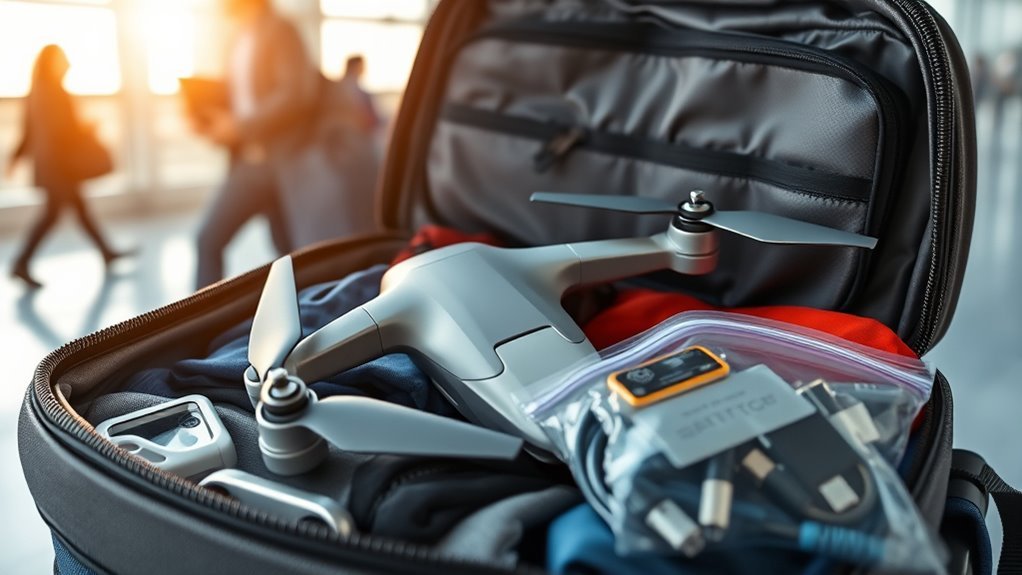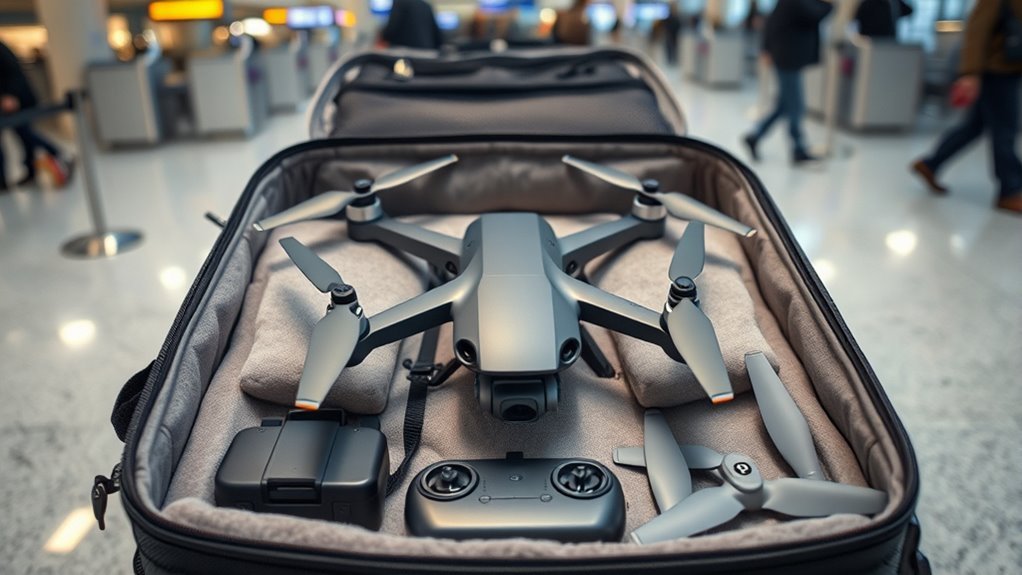To bring a drone on a plane, check your airline’s size and battery regulations. Pack your drone securely, removing accessories and using protective cases. At the airport, arrive early for security checks and inform personnel about your drone. Know local laws for drone operation at your destination and guarantee you have any necessary permits. After arrival, inspect your drone for damage. There’s more important information to help guarantee you’re fully prepared for your trip.
Understanding Airline Regulations

When you plan to bring a drone on a plane, it’s crucial to understand the airline regulations that apply to your journey. Each airline has specific policies regarding drone size, which can impact whether you can carry it as a personal item or in checked luggage. Generally, smaller drones may be permitted in the cabin, while larger ones often need to be checked. You’ll also need to take into account battery restrictions, as many airlines limit lithium batteries based on watt-hour ratings. Confirming your drone complies with these airline policies not only prevents potential issues at the airport but also guarantees a smoother travel experience. Always check the airline’s website for the most up-to-date regulations before your flight to avoid surprises. Additionally, it’s important to be aware of specific drone registration requirements in your destination country, as these can affect your ability to fly legally upon arrival.
Preparing Your Drone for Travel

Preparing your drone for travel involves several critical steps to guarantee it remains safe and functional during your journey. Start with thorough drone maintenance; check for any loose parts, clean the propellers, and make certain the battery is charged. It’s also wise to remove any accessories that could get damaged or cause issues during transport. Consider investing in travel insurance for your drone; this can cover potential damages or losses while traveling. Make sure to update any firmware to avoid issues during operation at your destination. Additionally, understanding signal attenuation is vital for ensuring optimal drone performance once you arrive at your location. Moreover, ensuring your drone’s design accommodates lightweight composites can enhance flight duration and overall durability during your travels. Finally, familiarize yourself with local regulations regarding drone usage to guarantee a smooth experience. With these precautions, you can enjoy your travels without worrying about your equipment.
Packing Your Drone Safely

When packing your drone for air travel, it’s essential to disassemble it to minimize the risk of damage. Using protective cases designed for your specific drone model can provide ideal safety during transit. This guarantees all components remain secure and intact throughout your journey.
Disassemble for Travel
To guarantee your drone arrives safely at your destination, it’s essential to disassemble it properly for travel. Start by removing the propellers, as they are delicate and can easily break. Next, detach the camera and gimbal if your drone has these components; they should be packed separately to avoid damage. Don’t forget to remove any batteries, as they often have specific regulations for air travel. Organizing your drone components not only protects them but also enhances travel efficiency, allowing for easier handling at security checkpoints. Use soft padding or dividers in your carry-on to keep everything secure. By taking these steps, you’re ensuring that your drone is ready for action upon arrival, giving you the freedom to explore.
Use Protective Cases
Using protective cases is essential for guaranteeing your drone remains intact during travel, especially since airports can be bustling and unpredictable. Choosing the right case can considerably enhance your drone protection, safeguarding it from impacts, dust, and moisture. Here’s what to take into account:
- Case Materials: Opt for hard shell cases made from durable materials like ABS or polycarbonate, which provide superior protection.
- Padding: Look for cases with custom foam inserts that hold your drone securely, preventing movement during transit.
- Size and Weight: Verify the case is lightweight yet spacious enough to accommodate your drone and accessories without cramming.
Navigating Security Checks
When you bring a drone on a plane, understanding the security screening process is essential. You’ll need to comply with battery regulations, as lithium batteries often have specific requirements. Proper preparation can help guarantee a smooth experience at the security checkpoint.
Security Screening Process
As you navigate the security screening process at airports, it’s essential to understand the specific regulations regarding bringing drones on a plane. Familiarizing yourself with security policies can save time and hassle. Here are three key points to keep in mind during screening procedures:
- Declare your drone: Inform security personnel that you’re carrying a drone, as this can expedite the process.
- Remove your drone from the bag: Place it in a separate bin for screening, similar to laptops and larger electronics.
- Check local regulations: Be aware that some airports may have additional restrictions on drones, so it’s best to confirm before your travel.
Battery Regulations Compliance
Understanding battery regulations is vital for guaranteeing a smooth security experience when traveling with your drone. Different battery types, such as lithium-ion and lithium-polymer, come with specific guidelines. Most airlines allow batteries under 100 watt-hours without additional approvals, but if yours exceeds this limit, you’ll need to check with your airline beforehand. Charging limits are important; typically, batteries should be at no more than 30% charge to comply with safety regulations. Confirm each battery is securely stored in carry-on luggage, as checked baggage may not be permitted. Familiarize yourself with the Transportation Security Administration (TSA) guidelines and your airline’s policies to avoid delays. Adhering to these regulations empowers you to travel freely with your drone and its batteries.
Checking Destination Rules
Before you pack your drone for a flight, it’s essential to check the specific regulations at your destination. Ignoring destination restrictions and local regulations can lead to fines or confiscation of your equipment. To guarantee a smooth journey, consider the following:
- Research Local Laws: Different countries and regions have varying rules regarding drone usage. Familiarize yourself with these before traveling, as aviation laws can significantly impact your drone operations.
- Check No-Fly Zones: Many areas, such as airports and national parks, have strict no-fly zones. Make sure your intended flight path is clear.
- Obtain Necessary Permits: Some destinations may require permits for drone operation. Always apply in advance to avoid complications upon arrival. Additionally, be aware that privacy regulations may also affect where and how you can operate your drone.
Best Practices for In-Flight Use
When flying with your drone, it’s crucial to adhere to best practices to guarantee safety and compliance. First, always make sure your drone is powered off and securely stowed during takeoff and landing. If you’re considering in-flight photography, wait until the aircraft reaches cruising altitude and it’s safe to operate electronic devices. Familiarize yourself with drone etiquette; avoid using your drone in crowded areas or near other passengers. Be respectful of fellow travelers’ space and privacy, and never fly your drone in the airplane cabin. Finally, check your airline’s specific policies regarding in-flight use before your journey. Following these guidelines not only enhances your flying experience but also fosters a responsible drone community.
Frequently Asked Questions
Can I Bring Extra Batteries for My Drone on a Plane?
You can bring extra batteries for your drone, but be sure to check airline policies. Drone battery regulations often limit watt-hour ratings; exceeding them could result in confiscation. Always verify before you travel.
Are Drone Parts Allowed in Checked Luggage?
If you think packing drone parts in checked luggage is a breeze, think again! Drone regulations and luggage restrictions can be tricky. Always check airline policies to avoid unexpected surprises and guarantee your freedom to fly.
What Should I Do if My Drone Is Damaged During Travel?
If your drone’s damaged during travel, assess the extent of the damage. Check your insurance policy for claims and explore repair options. Document everything thoroughly to support your claim and guarantee a smooth process.
Can I Fly My Drone Upon Arrival at the Airport?
Like a bird released, you might want to fly your drone at the airport, but you’ve gotta check local drone regulations and airport policies first. Freedom’s great, but rules keep you flying safely.
Are There Restrictions for International Drone Travel?
Yes, there are restrictions for international drone travel. You’ll need to research drone regulations and international policies of your destination country, as they can vary considerably and impact your ability to fly your drone freely.

